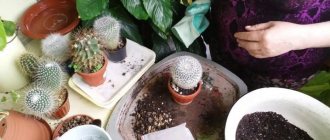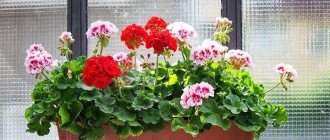A fairy tale about indoor plants for preschoolers
Fairy tale for children 5-7 years old
Educational fairy tale for preschool children “Green Hedgehog”
Author: Natalya Mikhailovna Golyshevskaya, senior teacher of MBDOU “Kindergarten No. 12” in Barnaul Purpose: this material is intended for preschool children Purpose: to expand preschoolers’ ideas about indoor plants Objectives: - to introduce children with features of appearance, structure, growing conditions of indoor plants; — teach how to perform labor actions to care for indoor plants; - develop curiosity, cognitive interest. Once upon a time there lived a Little Cactus. It was round, green and prickly. That's why they called him the Green Hedgehog. But he was prickly only on the outside, but in fact, the Cactus Child was very kind and sympathetic.
Recently, the owner separated him from his mother Cactus and planted him in a beautiful small pot. The little cactus liked his new house, but one thing upset him: plants unknown to him grew around him in large flower pots. But Little Cactus was sociable and inquisitive. He decided to get to know his “neighbors” better, because the Green Hedgehog so wanted to have friends! The first person the Cactus Kid dared to talk to was a plant with a thick, woody trunk, the round leaves of which looked like coins.
“Excuse me, please,” said the Green Hedgehog, a little embarrassed, “what is your name?” “People call me the money tree, people believe that I bring wealth and prosperity to the house, but scientifically I am called the tree crassula,” answered the tree. My homeland is the African savannah, so I love the sun. I also love it when my pot is turned from time to time, then I grow into a slender and beautiful tree. - Tell me, aren’t you bored of standing on the windowsill all the time? - asked Cactus. - No, of course, in winter I can watch what is happening outside the window, and in the warm season they send me “to the dacha,” that is, they take me out into the fresh air - onto the balcony. Here another plant with unusually beautiful leaves, on which bright red veins and spots stood out, intervened in the conversation: “And my name is arrowroot, I really love humidity and am afraid of direct sunlight, so I like it when the owner sprays my leaves with lukewarm water.” And I can also pick up leaves and fold them at dusk and even a few hours before rain, like a real barometer.
The little cactus listened very carefully to the stories of the plants, because he was still small and did not know much. An unusual plant grew in one of the pots; its dark green sword-shaped leaves with a pointed apex and light transverse stripes resembled fish scales. It turned out that this is a sansevieria, which is simply called “pike tail”. The little cactus even felt a little funny when he heard this name.
Suddenly the door opened and the hostess entered the room. In her hands was a pot with a very beautiful plant. “Meet this, this is your new neighbor,” she said (the owner often talked to her pets, because she believed that flowers, like living beings, understand everything and love when you communicate with them) “this is a fern. It will not only decorate the room, but also help clean the air from dust and harmful substances. It’s just a pity that the ferns don’t bloom, but they delight you with their varied leaves: huge, tiny and even curly.
The hostess put the pot down and left. So a “newbie” appeared on the windowsill. He quickly got used to the new environment and proudly talked about the fact that ferns are the oldest inhabitants of the Earth, existed along with dinosaurs and have survived to this day. So the Green Hedgehog not only met his “neighbors”, but also learned a lot of interesting and useful things.
We recommend watching:
For preschoolers about the seasons. A fairy tale about how Winter got lost. Summary of the GCD in the preparatory group on the topic “Getting to know the emotions.” A fairy tale for preschoolers. Shishkinsky Ponds Ecological fairy tale for children 6-9 years old
Similar articles:
A fairy tale about kindness for older preschoolers
Developing interest in folk art through familiarization with Russian folk tales in children of primary preschool age
Mamushi
Our 5-year-old daughter was assigned to give a short report about houseplants in kindergarten. Now they are studying different flowers, and some of the children were asked to be the teacher's assistants and make such reports for their comrades. I suspect that in fact it was for some commission or for an open lesson :).
We were given materials in kindergarten - two A4 sheets, where the text was clearly copied from some online encyclopedia. Naturally, there was a lot of purely scientific information that children could not remember or understand. I had to adapt and shorten the text. The result was two short stories - about geranium and about cactus.
Geranium
Geranium is a very beautiful plant. It can have white, pink, orange, red and crimson flowers. Geranium flowers grow close together on long stalks without leaves, so from a distance they resemble a colored umbrella. Many geraniums smell pleasant: orange, lemon, apple or rose.
Geranium loves light and should not be kept in a dark room. If a flower is placed in the shade for a long time, it will turn yellow and the leaves will fall off. In summer, geraniums need to be watered well, and in winter they should be kept in a cool place, away from radiators, and should be watered rarely.
Geranium is not only a beautiful, but also a useful plant. She is even called the “ear, nose and throat doctor” because she helps people cope with ear, nose and throat diseases. But mosquitoes, flies and moths, on the contrary, do not like the smell of geranium and fly away.
People have long noticed that geranium fruits look like the long nose of a crane. In different countries, geranium is called differently: stork's nose, crane's nose. And our Russian name “geranium” comes from the Greek “geranos”, which means “crane”. The birthplace of geranium is South Africa.
Cactus
Cacti are very unusual plants. They have a thick, succulent stem and no leaves at all. Or rather, there are leaves, only they have turned into thorns, fluffs or hairs. Cacti can be huge, taller than trees, or they can be small, no larger than a matchbox.
Most cacti bloom very beautifully, but for this they need to be properly cared for. Cacti love light, especially in winter. In hot weather, these plants need to be kept in the shade and the room must be ventilated, because cacti love fresh air. In summer, cacti are constantly watered, and in winter, watering is almost stopped.
It’s very nice to admire cacti, but you can’t touch them with your hands!
We also once came up with riddles about flowers. True, we didn’t talk about geraniums and cacti, but we’ll suggest it in the kindergarten - in case they also study some of these flowers.
Curious facts
- despite the fact that the official discovery of the violet occurred at the end of the 19th century, the flower was known in the Ancient world ;
- The Greeks believed that Zeus created the plant and left it in the gardens of Olympus. His daughter Persephone discovered the bushes and picked a bouquet. At that moment, the girl was kidnapped by the king of the underworld. While he was carrying the beauty to him, she dropped the bouquet, which ended up on the ground;
Painting by Walter Crane. "The Abduction of Persephone."
- Another ancient Greek legend says that the goddess of beauty Aphrodite was going to swim. At this time, she noticed several young men peeking at her. Dissatisfied, Aphrodite turned to Zeus. Zeus turned the young men into tiny violets;
- scientists came to the conclusion that the Greeks first learned about violets in 500 BC . The inhabitants of Greece considered this plant an aphrodisiac, used it as an ingredient in various dishes and added it to love alcoholic drinks;
- Now there are more than 10 thousand different varieties and hybrids of the plant ;
- At the end of the last century, an unusual space experiment was carried out. Saintpaulia seeds traveled in space for 6 years. After this, extraordinary abundantly flowering violets with light green fringe of petals grew from the seeds. The series was called Ever ;
- these flowers have beneficial properties . Thanks to the phytoncides released by the bushes, the air in the house is cleaned as much as possible. Such apartments have a good atmosphere, since phytoncides have a calming effect on people, improve metabolism, give strength and endurance;
- in Japan they created a dress with the scent of Saintpaulia . The pleasant smell does not disappear even after 5-8 washes;
- Saintpaulia is used to make one of the most unusual desserts in the world . The name of the delicacy is sugar violets : the flowers are covered with a layer of chicken protein and dipped in powdered sugar.
- Afterwards, they are thoroughly dried and stored in glass jars.
- The sweetness can be consumed as an independent dish or used to decorate dessert compositions.
Fairy tale for children
NOBLE IVY
One day Maria learned that flowers such as Ivy, Chrysanthemum, Aloe and Chlorophytum are amazing air purifiers, and she decided to grow these plants in her garden. The first thing she got was a very modest-looking, small and unprepossessing Ivy. No one paid any attention to him in the store, and he was sure that no one would ever need him. But Maria, of all the flowers sold in the store that day, chose this one. At home, she placed the Ivy on the windowsill next to the old Ficus, shining with its dark green leaves. Next to Ficus, little Ivy looked completely puny! But Mary reassured him: “Dear Ivy, soon you will outgrow all the flowers. A little patience!" And Ivy gained strength from these kind words. Indeed, with the onset of spring, he began to grow so quickly that he surprised himself. “Yes, I’m just changing before my eyes, these are miracles!” he thought joyfully. From a frail, inconspicuous bindweed, it has turned into an elegant plant with spreading curved stems, dotted with cheerful leaves, very beautiful in shape. All the spaces between the large leaves were filled with small ones. The leaf brothers were turned towards each other, as if someone had carefully laid out an emerald carpet of them. And the Ivy stems kept stretching and stretching and hanging in different directions. Ivy dreamed of reaching Azalea, who stood on the table near the window. Yes, just to get there, since he had legs - roots with the help of which he could move. These roots are located in Ivy at the very base of the leaves on the back side of the stem and serve Ivy for rapid movement and growth.
When Ivy finally got to Azalea, he touched her with the end of his emerald path and said joyfully:
- Phew, I finally got to you, madam! How are you? You are beautiful and look so young in your new leaves that I can’t help but express my admiration for you.
Azalea, who had recently thrown off her old green outfit, seemed very young in her new soft green dress. A little embarrassed by the words of the kind Ivy, she answered affably:
- Dear Ivy, thank you for your kind words, but now I’m painfully stuffy - the generous sun is baking my new tender leaves so much! I'm afraid they will burn out completely and I won't be able to bloom again. But I don’t want to move away from the window, without light I’ll die! And you, dear Ivy, how do you stand such heat?
“Oh, as for me, I’m very hardy, but I still prefer cool shade.” Who doesn't love it in the heat? - Ivy answered, and then sympathetically added:
- Madam, I am very sorry for you, and I will try to help you. Please be patient for a moment. I will direct all my stems up to the ceiling and give you and all the other flowers a wonderful shade in which you can take a break from the heat!
“I thank you from the bottom of my heart, noble Ivy.” Of course, I will be patient, but can you raise your stems that high?! After all, there are so many leaves on them!
“I’ll try, I have strong muscles!” I was able to reach you! “Once upon a time, even this seemed impossible to me,” Ivy answered and immediately set to work.
He strained with all his might and began to lift the end of the stalk from the table on which Azalea stood to the window frame. It was not easy: Ivy groaned and strained. Tiny droplets of sweat appeared on the stem and began to flow onto the leaves. Finally, with the end of the stem, Ivy managed to lean his elbows on the slippery window glass, and he was able to catch his breath. Then, having gained strength, Ivy walked on the glass again. The window glass was smooth, slippery, and there was nothing to grab onto. With each step of Ivy, a new leaf appeared on its stem, which lengthened the green path directed to the ceiling by one step. Sometimes Ivy’s stem would break and fall wearily, but after resting for a minute, Ivy would pick it up again. So, step by step, leaf by leaf, Ivy stubbornly walked towards his goal.
By evening, Ivy was tired and could no longer move a single leg. But the next morning he woke up before all the flowers and set to work with renewed vigor.
Step by step, leaf by leaf, he stubbornly crawled along the glass with his stems and said to himself: “Just a little more, just a little more, one more step, one more, just to reach the top frame...” He crawled and dreamed about how the flowers will breathe a sigh of relief, joyfully enjoying the shade that he will give them. And most of all he thought about Azalea.
When Maria came in the afternoon and approached her pets with a watering can in her hands, she gasped in amazement, almost dropping the watering can from her hands. The high stems of the Ivy covered the Azalea and other flowers from the scorching rays of the midday sun. The azalea shone with green freshness, as it had once in the winter when Maria first bought it.
Maria understood everything and began to watch with admiration the stalks of Ivy, which from top to bottom covered the entire corner of the window with their delicate green leaves.
The stems of the Ivy were now the first to receive the blows of the hot rays, and through them soft sunlight easily streamed into the room. Geranium, Cyclamen, Decembrist, Chrysanthemum sighed with relief and raised their heads, rustling their leaves gratefully. And Azalea was the most happy. The courageous Ivy gently touched her with its stems, and they whispered about something.
Maria watered the Ivy abundantly and thought: “I need to water it more, because my flowers need it so much!”
>>
Questions and tasks for the fairy tale:
Show the children drawings of indoor plants from the fairy tale.
What plants growing in the field and garden remind you of Ivy? How does the character of Ivy differ from the characters of other indoor plants?
Which indoor plants seem modest in appearance to you? What external features of a plant tell you about its modesty? Are there bullies and braggarts among plants?
Do you think that if Maria had not calmed Ivy down and encouraged him, would he have grown so fast?
Draw Ivy at the very beginning of the fairy tale, and then after he has grown.
What do you think Mary's different plants thought of Ivy?
Choose a houseplant, watch its growth and write the life story of this plant.
Draw a “carpet path” of ivy leaves. Do you know indoor plants whose leaves, like Ivy leaves, are arranged in a path and have legs and roots for movement?
Why do you think Ivy dreamed of reaching Azalea?
Which plants do not tolerate heat well? List these plants. What do you think needs to be done to prevent plants from suffering from heat and stuffiness?
If you were one of the residents of Mary's kindergarten, what would you do to help Azalea? Write a story about it.
Draw Ivy walking courageously on the glass. What helped Ivy grow upward, no matter what?
What do you think Ivy and Azalea were whispering about?
Have you ever noticed that a particular houseplant does something very important and useful for others?
Write a fairy tale about how Mary’s houseplants, in turn, helped Ivy.
LiveInternetLiveInternet
Quote from Laurita_storyteller
Read in full In your quotation book or community!
Geranium in fairy tales and parables for children and adults
Fairy tale-parable “Magic geranium”
Once upon a time there lived a woman. Everything would be fine, but the woman lived in a very gray and uncomfortable house, and therefore she herself often felt sad, especially when autumn came. This woman was not evil, but she really loved to complain about her boring, gray life. Not a day went by without her going to visit one of her neighbors and complaining about her life. It seemed to her that others were always luckier than her.
One day, this woman’s neighbor, who was tired of eternal complaints, gave her a flower in a bright pot. It was the most common geranium that can be seen in any home. The neighbor said to the woman:
- This is a magic geranium! Put it on the table, water it twice a week, and you will see that it can work real miracles.
The woman was surprised by these words, but the neighbor was always cheerful and beautiful, and her home was so wonderful and cozy that she decided to try the magic flower. She brought the geranium home and put it on the table.
Two days passed, but nothing miraculous happened.
- How so? – the woman thought. She examined the flower from all sides. The geranium was very beautiful, with lush pink flowers, in a bright, elegant pot. “She probably doesn’t like standing on such an ugly table without a tablecloth.”
The woman took a linen tablecloth with embroidery from the closet and laid it on the table.
“No,” she decided. - One tablecloth is not enough here.
And she got to work. First, she washed all the dishes, washed the gray curtains and sewed elegant lace onto them. Then I took paints and painted the stools in different colors. But even this seemed not enough to her. She even painted the walls in bright colors and laid a knitted rug on the floor.
The day flew by unnoticed. The woman was so carried away by her work that she even forgot to visit her neighbors to complain about something. When a surprised neighbor stopped by, the woman greeted her joyfully and invited her to drink tea and pies.
- This is truly a magical geranium! Thank you! - she told her neighbor.
Grandma Fedora and Geranium (ecological fairy tale for preschoolers) Vorotnikova Lyudmila Fedorovna Once upon a time there lived a Geranium. Poor, unfortunate Geranium. She was once very beautiful. And now... What happened to her. The flowers withered, the leaves withered, and the roots had long lost their strength... The earth in the cracked pot asked for clean water... but no one could help either the earth, or the flowers, or the leaves. And Fedora’s grandmother was to blame for it all. Lazy and slob. She did not look after Geranium and generally forgot about her a long time ago. And poor Geranium tried with all her might to make the world around Grandma Fedora beautiful... but all her attempts were in vain. And then the day came when Geranium’s strength was running out... And she decided to leave grandmother Fedora. Left her. She looked lonely at the house in which she lived and left. Grandmother Fedora woke up in the morning and did not understand what had happened. “I’m not feeling well today, I’m restless and I feel bad.” What is it, why is this? For a long time, Fyodor’s grandmother could not understand what was wrong. But then a mouse appeared from behind the stove. - What, grandma, are you feeling bad? - Bad mouse, bad.. - Can I tell you why? - Why? - This is all because Geranium left your house. Only now, after the words of the mouse, Grandma Fedora noticed that the window sill near the dirty, dusty window was empty. “You probably don’t know,” the mouse continued, “but Geranium is a special plant.” Its aroma heals the human soul, calms, protects and helps to cope with all difficulties. “I didn’t even know...” Fedora sighed sadly. – But even if I knew... For all the time that Geranium lived with me, I never felt its beneficial influence on me. – Did you look after her? - What, it was necessary to look after? - Certainly! Water the soil, loosen it, nourish the roots. And she also needs sunlight... And look at your window - dusty, dirty! - Oh, what should we do now? - Grandmother Fyodor sighed. “Go and return the Geranium,” the Mouse simply answered. And Grandma Fedora walked through the fields, through the meadows... She walked for a long time. I came to the clearing. He sees her Geranium sitting all so poor, unhappy... She sheds bitter tears. - Geranium, dear, forgive me. I feel so bad without you. Come home, please. I will take care of you, look after you. Geranium forgave Grandma Fedora. They returned home. Fedora's grandmother planted the geranium in a new pot, poured new soil, loosened it, watered it, and also washed the window so that the sun's rays would caress the geranium flowers with their warmth and light. And the Geranium bloomed with happiness and filled Fedora’s house with a wonderful, beneficial aroma. Since then, Fedora’s grandmother has taken care of her Geranium and always takes care of it.
How a sprout got a name (an ecological fairy tale for preschoolers) Vorotnikova Lyudmila Fedorovna In one small town there was a small kindergarten in which small but very good children were raised. They loved animals, birds, and plants very much. The children, although still very small, were already able to take care of the inhabitants of their living corner. These were such good and obedient children. But when the kids went home and the kindergarten corridors became quiet, the plants and animals talked to each other. And then one day Lily, who was standing on the windowsill next to Begonia, exclaimed in surprise: “Look, next to me there is a pot in which there is nothing but soil.” “You know, dear Lily,” said Begonia, “I saw how the children diligently watered this land today.” “It’s strange,” Cactus sighed, “empty land, but they water it...” “And there’s nothing strange about it,” said the wisest of all plants, Fern. – Since our children are watering this earth in a pot, it means they are waiting for something. – What can they expect? – Lily was surprised. - Like what? A new small sprout that will appear from a small seed, which in turn is still hiding deep in the ground. - Oh, that's it! – all the plants gasped at once. – So, soon we will have a new pet! – I wonder who he will look like? - Begonia asked, and at once the plants’ suggestions began to pour in from all sides, because each of them believed that the sprout would look exactly like it. Meanwhile, the little seed grew into a small sprout. Once, when the indoor flowers were once again arguing about something unclear, they heard a thin voice: “Hello!” - Oh, just look, our little sprout was born! - Lily exclaimed. - Hello, sprout! – Begonia greeted. - What is your name? “I don’t know...” the sprout became sad. - That is OK. “Don’t worry,” Fern reassured him. “We all know our names here, they are written on the signs of our houses.” As soon as you grow up a little, we will see who you are like and find out your name. Days passed after days. Every day the children looked after the sprout. They watered it and loosened the soil, fed it with vitamins. And the sprout kept growing, gaining strength and filling the space around itself with a wonderful, soothing aroma. - What is my name? – the sprout was perplexed. – All the flowers around me have names. And who am I? Several more days passed like this. The sprout has ceased to be just a sprout. It grew and turned into a fragrant flower, with soft carved leaves, with small pink flowers, each petal of which looked like a small heart. The solemn moment has arrived. One fine morning, the children attached a name to the flower pot. “Geranium” was written on this sign, and at night, when the kindergarten was empty again, all the residents of the living corner noticed that the new pet now had a name. “Hello Geranium, welcome Geranium, how are you doing Geranium,” was heard from all sides, and young Geranium was incredibly happy that now she too knows its name. So from a small sprout a houseplant grew, which still lives in one small kindergarten, where small but very good children are raised.
Court perfumer (ecological fairy tale for older preschoolers) Nedina Elena Alekseevna In a certain kingdom, a flower state, the glorious king Abutilon lived and reigned. This was a real king: proud and even a little formidable, as a real king should be. In this flower kingdom, all the inhabitants had a lot to do, but those who served the capricious king had to work the most. "I feel hot!" - he could say out of the blue. And immediately, his servant, Ficus, spread his huge leaves over Abutilon and, like umbrellas, covered him from the bright rays of the sun. So the court perfumer always had a lot of work. And the king’s respected Geranium was the court perfumer. Her sister, Fragrant Geranium, also served the king - she was an indispensable assistant to the royal physician, Mr. Aloe. In addition, Mr. Aloe had another assistant, whose name was Doctor Bryophyllum. He became famous for being the best at treating a runny nose. And everyone knew Fragrant Geranium as a healer. It could quickly relieve pain if you had an earache. But, we got a little distracted, so let’s return again to the respected Geranium. You may ask why she was appointed chief perfumer of the flower kingdom? Yes, it’s very simple: after all, you just need to touch its leaves and you will immediately feel a wonderful aroma. Let's tell you frankly that some residents of the flower kingdom considered the respected Geranium to be a bit of a sorceress, but she herself was simple, modest and unpretentious, and did not consider her ability to create fragrances to be something extraordinary.
A fairy tale-legend about the good Geranium Tatyana Karpova We will tell you a fairy tale about “grandmother’s” flower, which is popularly called geranium, and its scientific name is pelargonium. This tale is about kindness, love and mercy. Once upon a time there lived a kind girl, Gerana, in the city. She was an orphan, lived with strangers and warmly responded to the grief of others. One day, on a cold, cloudy day, Gerana met an unfamiliar girl, she was walking and crying. It turned out the girl’s name was Eliza, she has a sick mother, and she really loves flowers. And yesterday she said that if there was a flower on our window, she would look at it and think about life, not about death. So Eliza decided to go to the rich gardener and ask for one pot, because he has so many beautiful flowers in his greenhouse. But he pushed her out the door, she fell, hurt herself and tore her dress. “Don’t cry, don’t cry,” she consoled her, but her heart sank with pity. I'll walk you home. The small room where Eliza lived with her mother was uncomfortable and gloomy. It would be happier and brighter here if there was a lush flower on the window, thought Gerana. And she stayed overnight with her new friends. She could not sleep, she kept thinking that, probably, many poor people would be glad to see beautiful flowers on their windows. Gerana's heart began to beat heavily. “Oh, how I would like to turn into such a flower,” she thought, “so that it would amuse and delight the soul, without demanding anything special for itself!” How much joy I would bring to poor people! “How sweetly I fall asleep,” the girl whispered, “I’ve never felt so good!” ...And in the morning, when Eliza and her mother woke up, they could not believe their eyes: on their small window sill, in a modest clay pot, a cheerful bush was blazing with large caps of flowers. He extended his green leaves to them, like tender palms. - This is a gift from Gerana! – Eliza exclaimed, “But she’s not there.” This means she left so early to bring us this wonderful flower. And soon the same green bushes appeared on many windows. After all, they easily and willingly took root, even from a small sprout given from the heart, and delighted people without requiring rich greenhouses. No one knew that Gerana’s kind heart continued to beat within them, but in gratitude and in memory of her, this beloved flower was named geranium.
A fairy tale about a geranium Galina Pletnyova In one flower pot there lived a little Gerania. She had everything - soft, warm and moist nutritious soil, light, clean air. It seemed like live and be happy, but she just couldn’t get used to loneliness, often remembering her mother Geranium, her strong stem, beautiful hats of flowers... Geranya still remembers the strong fingers that quickly and mercilessly pulled her out of her mother’s embrace and put her in a glass jar with water. After the roots appeared, she was placed in the ground, in this pot, where the poor child thought about her mother all the time, bitterly complaining about her unfortunate sad fate. Geranka was in complete decline, but the unexpected happened. One day a seed fell next to her - plump, smooth and very important. It lay down comfortably and fell asleep, waking up from time to time to drink some water and roll over onto the other side. Having become interested in her unexpected neighbor, the orphan forgot about her grief, listening to how the seed was breathing. Some time has passed. One day she heard a quiet crackling sound and, looking around, saw instead of a seed a thin, weak stem, which fearfully and helplessly looked with two tender leaves at an unfamiliar world. Geranka suddenly felt pity and compassion for him. Having hugged and pressed the stem to her, she whispered tender, encouraging words to him. When he got stronger, fluffed up a few leaves and could already hold his back on his own, Geranka carefully asked who he was. “Citrus,” the sprout politely bowed and in response heard the neighbor’s name. After a while they knew everything about each other. – You shouldn’t be sad, Geranka. At some point, children must leave their parents to start their own lives. I also had a mother and father, brothers and sisters, but I knew that separation would come and was ready to fulfill my destiny - to continue the Citrus family. That’s why I drink water and draw juices from the earth, accept any sincere help, trying to become strong, healthy and beautiful. Geranka felt ashamed: so big, but still reaching out to her mother, not thinking at all about her destiny. From that day on, life in the flower pot changed dramatically. The geranium helped the ward preserve new leaves, scaring away the insects hungry for tasty treats, and on cool nights covered the fragile body of the overseas plant, accustomed to the warmth, with its leaves. And Citrus tirelessly gave his guardian compliments that were pleasant to all the ladies, taught flower etiquette - to stand straight and proud, gracefully opening carved leaves, subtly exuding a unique aroma, attracting attention with bright, wonderful flowers. – Only the happy ones bloom! – the gentleman tirelessly reminded his young lady. But one day something almost happened. Those fingers that tore Geranka away from her mother began to persistently, albeit carefully, pull Citrus out of the ground, but Geranka clung to her friend so tightly that her fingers left the sprout alone. After such a shock, they realized how much they needed each other, and they tangled their roots so much that no force could separate them. Since then, Citrus and Geranka have lived, helping each other, enjoying every day, surprising others with flowers and bright greenery. They look at each other with a smile and think about the same thing: true friendship and selfless support will be able to cope with any troubles, and most importantly - to believe how unique, unique and desirable YOU are. And it doesn’t matter what language you speak, what songs you sing, what clothes you wear. It is important to know that the Sun shines equally on everyone, and everyone wants to live, fulfilling their destiny with dignity.
Parable “Grandfather and Geranium” Stanislav Dimov She was a small, frail little creature. A stunted geranium, seemingly doomed to extinction, with twisted, yellowed leaves. Grandfather picked her up from the neighbor's fence. - So, you’ll freeze, poor thing, frost is on your nose, however. Grandfather treated any blade of grass or blade of grass with reverence and love. He planted the geranium in a large, beautiful pot and placed it on the windowsill, next to the begonia and violets. Grandfather doted on the foundling. He doesn’t drink the milk or cream and pours it into the pot. Very soon, surrounded by love, care and affectionate glances, the geranium turned into a real beauty. The beautiful rose herself was jealous of her height and slender figure. The succulent, lacy leaves shone with a bright green gloss. Proud, majestic, she towered above her neighbors. One problem: the geranium did not bloom. Years passed, but the flower never pleased the eye, even with one single, inconspicuous flower. -Well, you dear, aren’t you blooming? What don't you like? Maybe I'm doing something wrong? – the saddened grandfather asked once again. -And she’s not ashamed, the damned one. Her grandfather dotes on her, but she feels sorry for the flower for him. What a lady. – Her neighbors whispered. Life takes its toll. Grandfather died without waiting for his pet to bloom. When the coffin was taken out of the apartment, they accidentally touched a geranium, breaking its crown. -Serves you right, heartless. Let's see... What will happen to you without your grandfather? - The violets rustled. After the death of my grandfather, the geranium was taken out onto the veranda - its lush greenery almost did not let in the sun's rays. The pot in which the beauty grew was too large and took up a lot of space. The geranium was transplanted into a small container. The flower was not watered often - the grief-stricken household had no time for it. A couple of months later, to the surprise of everyone, the geranium bloomed. It bloomed with unusually huge, bright scarlet flowers. No one has ever seen such flowers again... And only grandfather is an old, affectionate, caring grandfather who gave his soul to his favorite. I never saw it... -It’s too late, dear, you won’t bring grandpa back... The story-parable “Geranium in the Snow” from the book “Zatesi” by V.P. Astafiev A drunken man was raging in the barracks. His wife tried to calm him down. He hit his wife and she flew into the corridor. The kids ran away even earlier. The drunk man began to look for something to break. But everything in the room was already broken and destroyed.
Sad for the man.
And then he saw a geranium on the window.
A geranium grew in a leaky cast iron pot. They forgot to water it, and therefore the lower leaves of the geranium soon turned black, curled up and fell off. But the geranium gained strength and grew and blossomed. She only had one flower and from the heels of leaves that froze to the window at night, and like the stove was flooded, they thawed.
The man slammed a cast iron into the glass. A geranium fell under the window. The cast iron soil fell out into the snow. The man calmed down after that and fell asleep.
All night the geranium glowed under the window, still alive. The next morning it snowed and dusted her.
During the day, a man was covering a window with plywood and saw a geranium. It glowed dimly under the snow. It seemed like a drop of blood to the man, and he stopped working and froze heavily near the window.
And the geranium kept getting covered and covered with snow. So it quietly went out, and the man thought that it was better for the geranium to be quiet under the snow, and warmer, and not suffocated by the barracks.
Spring is coming soon. The snow under the windows of the barracks was washed away by streams, and the water picked up a stem of geranium with a wet black flower and carried it into the ravine. The root of the geranium turned out to be alive, and with this root the geranium caught the ground and began to grow again. But when two leaves came out and the geranium became noticeable, a goat found it in the ravine and ate it.
The root of the geranium still remained in the ground, and, having gained strength, it sprouted again. Then construction began and an excavator arrived. He hooked the geranium along with the sting with a ladle and threw it into the car, the car dumped the earth under the ravine, towards the river.
The geranium moved in the loose soil, tried to grow in a new place, but they kept pouring earth on top of it, and it could no longer grow, calmed down, and its root lost its strength under the weight and began to rot inside the earth, along with chips and rubbish and buried grass.
The hostess picked up the leaky cast iron pot and planted a tomato in it. The man did not throw the cast iron pot with the tomato out the window, although the man still drank and raged after every paycheck and was always looking for something to break and throw away.








